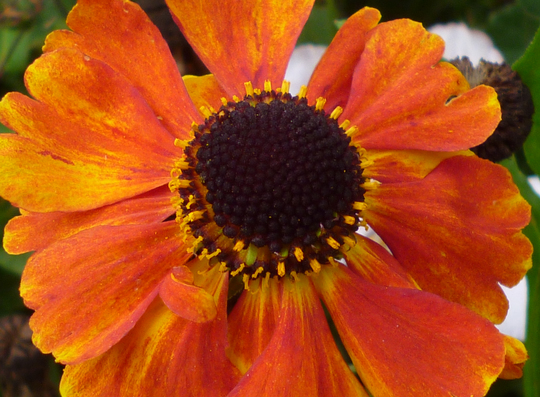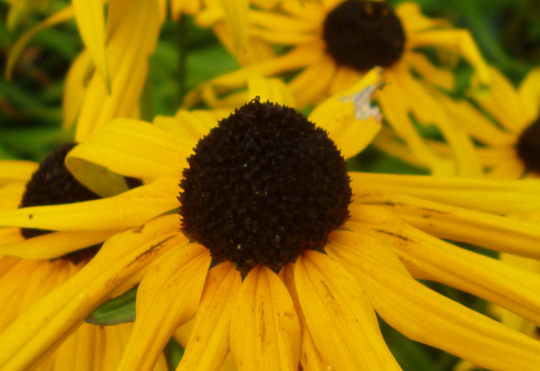When finding the center helps!
By seaburngirl
23 comments
This concept is a good one in sewing but also in helping to identify plants at least at genus level.
Recently several members have asked “what is this please?” and from our experiences we have suggested a few ideas: Helenium, Rudbeckia or Helianthus.
I have all 3 growing in the garden so I had a close look today. What we call the flower is a composite, bracts and lots of individual flowers.
The brightly coloured ‘petals’ are not true petals but coloured bracts and a way of advertising the true flowers in the central disc. This is true for the daisy family.
Helenium such as ’Sahin’s Early Flower’ behaves like another one that is called ’Helen’s Red’. The leaves are similar too. Both have a central disc that has flowers where male parts and female parts open at different times to ensure a greater chance of cross pollination.
Tightly packed central disc of H. Sahin’s Early Flowerer

This is H. ’Helen’s Red’ and there are some female parts stigma’s just visible at the base of the out disc against the red of the petals. They look a bit like curly letter Y’s

The individual flowers are opening as the disc develops.

Even more open.

Fully open and the flower center looks golden.

I also have two Rudbeckia in flower, R. ‘Goldsturm’ and R. ‘Deamii’. Their leaves are slightly different, Goldsturm is darker and more toothed. Deamii paler and less toothed. The flowers look very similar. Their central disc is dark and cone shaped. The development of the male and female flowers in the central cone is gradual, again allowing for cross pollination to occur. The central disc rarely seems to change colour in the ones I have.
Rudbeckia ‘Deamii’

The earliest flowers to open are towards the base just like Helenium but the cone stays dark.

This is Rudbeckia ‘Goldsturm’, similar flower structure.

The flowers of the central disc opening from the bottom up.

Almost fully ‘done’ and the seeds stay in the individual black section of each flower.

Helianthus ‘Lemon Queen’, is like the others in full flower at the back end of the year.
This flower also opens in the same manner and the basic structure is the same. However the disc is yellowish.

As you can see the actual flowers start opening from the outside of the disc.

Nearly all open now.

I hope you can see what I mean by the way the flowers look and the way you can use this to help identify the plant in question.
 19 Sep, 2021
19 Sep, 2021 10 likes
10 likes
Previous post: Eucomis: I blame the children.
Next post: November - already 9 days in.
Comments
Very interesting to see the various forms Eileen. From what I understand the fibonacci number sequence is always a constant. Is that true?
20 Sep, 2021
Number sequence of what Paul? Can't see what you're applying it to - do you mean the central disc?
20 Sep, 2021
sadly not as there are always the odd individual that doesn't obey and has extra or missing petals etc. But some groups of plants generally follow the sequence.
20 Sep, 2021
So do you mean the petals then? Were you hoping to use it to tell one variety from another?
20 Sep, 2021
Great blog Seaburn, I often get mixed up with these particular ones as at first glance and from a distance they look the same, I have both Rudbekia and Helianthus so I'm going out to study them...Fascinating, I'm adding to my favs as I don't always remember all the info these days, its an age thing , lol....
20 Sep, 2021
Great informative blog, thank you for sharing.
21 Sep, 2021
Lots of good information there,SBG! 👍 👏
21 Sep, 2021
I agree so many varieties and cross breeds. Wild flowers don't follow anybody's rules - good for them, lol.
21 Sep, 2021
That's what I assumed Paul meant Stera but it can be applied to any of the flower parts.
22 Sep, 2021
That was a wonderful blog, I enjoy learning about plants more than anything. This information is very helpful. I've saved it to my favs :)
22 Sep, 2021
Oh - I was referring to the arrangement of the seeds inside the central disc. The Fibonacci sequence is a series of numbers in which each number is the sum of the two before it. I just thought it was fascinating to see this sequence in nature. It's highly ordered and beautiful.
22 Sep, 2021
Gorgeous pics, Eileen! Love the colours and the detail is great - plus thank you for all the info too - a learning curve!
22 Sep, 2021
You're right Paul. The more we discover about the natural world the more amazing it is. Same thing with fractals.
22 Sep, 2021
That's true amazing!
22 Sep, 2021
glad you all liked it and hopefully it will be of use when identifying plants in the future
Fern id often relies on fractals Stera as do some trees.
22 Sep, 2021
Does it? Fern ID can be really challenging if (like me)you aren't sure what you're doing...The more you look the more amazing it all is...
23 Sep, 2021
One of Victoria's id guides [ferns] has very detailed images of the way the fronds dissect/split. It took us both a while to get our heads round it.
24 Sep, 2021
Seaburgirl , thank you for this. I think that mine is the Helianthus Lemon Queen as the centre is yellow now. Thank you for all this information
24 Sep, 2021
Eileen, when our son Mike was doing some degree work he had to produce a collection of identified ferns. He visited us because this is a very ferny place. Half of them I would just write off with "Oh that's just another Dryopteris" but oh dear me it wasn't! Very sobering it was...
9 Nov, 2021
Nothing wrong in saying Dryopteris, lots of them. I am dreading Toria choosing something similar for her Masters, I am hoping she is going down the moth/butterfly lane!
10 Nov, 2021
Recent posts by seaburngirl
- Not my other garden!
28 Mar, 2025
- wont be sorry to see the back of January!
31 Jan, 2025
- farewell 2024
31 Dec, 2024
- Seasons Greetings
22 Dec, 2024
- Went up home.
3 Dec, 2024
- Some sad news
20 Jul, 2024
Members who like this blog
-
Gardening with friends since
21 Nov, 2013 -
Gardening with friends since
1 Oct, 2013 -
Gardening with friends since
22 Oct, 2008 -
Gardening with friends since
29 Oct, 2013 -
Gardening with friends since
4 Apr, 2009 -
Gardening with friends since
2 Nov, 2009 -
Gardening with friends since
2 Feb, 2019 -
Gardening with friends since
11 Feb, 2010 -
Gardening with friends since
31 Mar, 2010 -
Gardening with friends since
9 Aug, 2009


Fascinating - thank you!
19 Sep, 2021